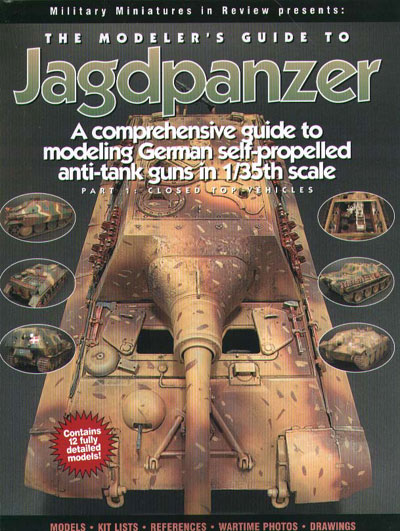| |
The Modeler’s Guide to Jagdpanzer,
A comprehensive guide to modelling German self-propelled anti-tank guns
in 1/35th scale, part 1: closed top vehicles
by Jim Hensley

Ampersand Publishing Co, Inc, no ISBN, 120 pages
This is not just a description of how to build Jagdpanzers but a respectable
reference as well. It includes quite a few period photographs, colour
closeups of preserved vehicles, and good text about the development and
deployment of the real vehicles that gives you the needed information
to distinguish early and late versions. The first section is on “Hetzers”
and here we get early and late production versions and the “Hetzer
Starr” as well, with four pages of historical text, 13 period photos
and 38 colour shots of external and internal details plus 3-view 1/35
plans of the three variants modelled. The models are based on the DML
kits, the Starr using an Accurate Armour conversion, and in each case
appropriate aftermarket etch sets, tracks etc are used. The building and
painting processes are described in detail, with plenty of photographs
so no-one should have any problems in using them for their own models.
Next are the Jagdpanzer IV type, L/48, L/70 (V) and L/70 (A) with a
similar mix of reference text, period photographs and preserved vehicle
closeups though fewer of the latter in this case, and plans. Again, DML
kits are used with etch, tracks, etc from the aftermarket and, again,
every step is described and shown in photographs. Then comes the chapter
titled “The Heavyweights” – Ferdinand and Elefant, early
and late Jagdpanthers, and Jagdtigers with both Porsche and Henschell
suspensions. The mixture is as before, very comprehensive and useful reference
material followed by clear descriptions of photographs of how the models
can be built.
To end the book there’s a section listing all the kits and accessories
used and recommended references, arranged by vehicle type so easy to use,
followed by one listing all the available kits and accessories and one
on where to see surviving vehicles.
This is as good as the earlier MMiR Modeler’s Guides – highly
recommended!
John Prigent
|
|